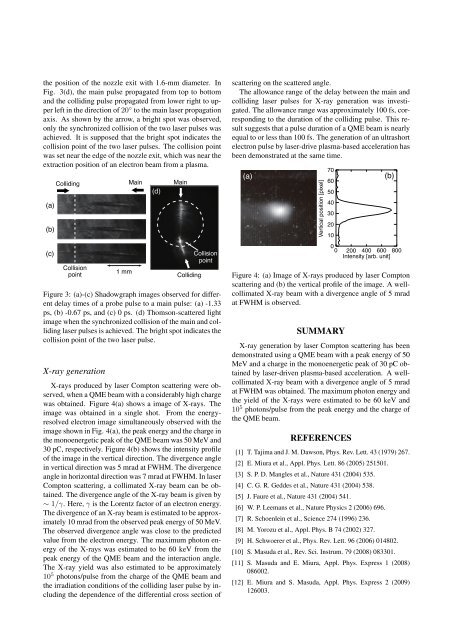Proceedings of International Conference on Physics in ... - KEK
Proceedings of International Conference on Physics in ... - KEK
Proceedings of International Conference on Physics in ... - KEK
You also want an ePaper? Increase the reach of your titles
YUMPU automatically turns print PDFs into web optimized ePapers that Google loves.
the positi<strong>on</strong> <str<strong>on</strong>g>of</str<strong>on</strong>g> the nozzle exit with 1.6-mm diameter. In<br />
Fig. 3(d), the ma<strong>in</strong> pulse propagated from top to bottom<br />
and the collid<strong>in</strong>g pulse propagated from lower right to upper<br />
left <strong>in</strong> the directi<strong>on</strong> <str<strong>on</strong>g>of</str<strong>on</strong>g> 20 ◦ to the ma<strong>in</strong> laser propagati<strong>on</strong><br />
axis. As shown by the arrow, a bright spot was observed,<br />
<strong>on</strong>ly the synchr<strong>on</strong>ized collisi<strong>on</strong> <str<strong>on</strong>g>of</str<strong>on</strong>g> the two laser pulses was<br />
achieved. It is supposed that the bright spot <strong>in</strong>dicates the<br />
collisi<strong>on</strong> po<strong>in</strong>t <str<strong>on</strong>g>of</str<strong>on</strong>g> the two laser pulses. The collisi<strong>on</strong> po<strong>in</strong>t<br />
was set near the edge <str<strong>on</strong>g>of</str<strong>on</strong>g> the nozzle exit, which was near the<br />
extracti<strong>on</strong> positi<strong>on</strong> <str<strong>on</strong>g>of</str<strong>on</strong>g> an electr<strong>on</strong> beam from a plasma.<br />
(a)<br />
(b)<br />
(c)<br />
Collid<strong>in</strong>g Ma<strong>in</strong> Ma<strong>in</strong><br />
(d)<br />
Collisi<strong>on</strong><br />
po<strong>in</strong>t<br />
1 mm<br />
Collid<strong>in</strong>g<br />
Collisi<strong>on</strong><br />
po<strong>in</strong>t<br />
Figure 3: (a)-(c) Shadowgraph images observed for different<br />
delay times <str<strong>on</strong>g>of</str<strong>on</strong>g> a probe pulse to a ma<strong>in</strong> pulse: (a) -1.33<br />
ps, (b) -0.67 ps, and (c) 0 ps. (d) Thoms<strong>on</strong>-scattered light<br />
image when the synchr<strong>on</strong>ized collisi<strong>on</strong> <str<strong>on</strong>g>of</str<strong>on</strong>g> the ma<strong>in</strong> and collid<strong>in</strong>g<br />
laser pulses is achieved. The bright spot <strong>in</strong>dicates the<br />
collisi<strong>on</strong> po<strong>in</strong>t <str<strong>on</strong>g>of</str<strong>on</strong>g> the two laser pulse.<br />
X-ray generati<strong>on</strong><br />
X-rays produced by laser Compt<strong>on</strong> scatter<strong>in</strong>g were observed,<br />
when a QME beam with a c<strong>on</strong>siderably high charge<br />
was obta<strong>in</strong>ed. Figure 4(a) shows a image <str<strong>on</strong>g>of</str<strong>on</strong>g> X-rays. The<br />
image was obta<strong>in</strong>ed <strong>in</strong> a s<strong>in</strong>gle shot. From the energyresolved<br />
electr<strong>on</strong> image simultaneously observed with the<br />
image shown <strong>in</strong> Fig. 4(a), the peak energy and the charge <strong>in</strong><br />
the m<strong>on</strong>oenergetic peak <str<strong>on</strong>g>of</str<strong>on</strong>g> the QME beam was 50 MeV and<br />
30 pC, respectively. Figure 4(b) shows the <strong>in</strong>tensity pr<str<strong>on</strong>g>of</str<strong>on</strong>g>ile<br />
<str<strong>on</strong>g>of</str<strong>on</strong>g> the image <strong>in</strong> the vertical directi<strong>on</strong>. The divergence angle<br />
<strong>in</strong> vertical directi<strong>on</strong> was 5 mrad at FWHM. The divergence<br />
angle <strong>in</strong> horiz<strong>on</strong>tal directi<strong>on</strong> was 7 mrad at FWHM. In laser<br />
Compt<strong>on</strong> scatter<strong>in</strong>g, a collimated X-ray beam can be obta<strong>in</strong>ed.<br />
The divergence angle <str<strong>on</strong>g>of</str<strong>on</strong>g> the X-ray beam is given by<br />
∼ 1/γ. Here, γ is the Lorentz factor <str<strong>on</strong>g>of</str<strong>on</strong>g> an electr<strong>on</strong> energy.<br />
The divergence <str<strong>on</strong>g>of</str<strong>on</strong>g> an X-ray beam is estimated to be approximately<br />
10 mrad from the observed peak energy <str<strong>on</strong>g>of</str<strong>on</strong>g> 50 MeV.<br />
The observed divergence angle was close to the predicted<br />
value from the electr<strong>on</strong> energy. The maximum phot<strong>on</strong> energy<br />
<str<strong>on</strong>g>of</str<strong>on</strong>g> the X-rays was estimated to be 60 keV from the<br />
peak energy <str<strong>on</strong>g>of</str<strong>on</strong>g> the QME beam and the <strong>in</strong>teracti<strong>on</strong> angle.<br />
The X-ray yield was also estimated to be approximately<br />
10 5 phot<strong>on</strong>s/pulse from the charge <str<strong>on</strong>g>of</str<strong>on</strong>g> the QME beam and<br />
the irradiati<strong>on</strong> c<strong>on</strong>diti<strong>on</strong>s <str<strong>on</strong>g>of</str<strong>on</strong>g> the collid<strong>in</strong>g laser pulse by <strong>in</strong>clud<strong>in</strong>g<br />
the dependence <str<strong>on</strong>g>of</str<strong>on</strong>g> the differential cross secti<strong>on</strong> <str<strong>on</strong>g>of</str<strong>on</strong>g><br />
scatter<strong>in</strong>g <strong>on</strong> the scattered angle.<br />
The allowance range <str<strong>on</strong>g>of</str<strong>on</strong>g> the delay between the ma<strong>in</strong> and<br />
collid<strong>in</strong>g laser pulses for X-ray generati<strong>on</strong> was <strong>in</strong>vestigated.<br />
The allowance range was approximately 100 fs, corresp<strong>on</strong>d<strong>in</strong>g<br />
to the durati<strong>on</strong> <str<strong>on</strong>g>of</str<strong>on</strong>g> the collid<strong>in</strong>g pulse. This result<br />
suggests that a pulse durati<strong>on</strong> <str<strong>on</strong>g>of</str<strong>on</strong>g> a QME beam is nearly<br />
equal to or less than 100 fs. The generati<strong>on</strong> <str<strong>on</strong>g>of</str<strong>on</strong>g> an ultrashort<br />
electr<strong>on</strong> pulse by laser-drive plasma-based accelerati<strong>on</strong> has<br />
been dem<strong>on</strong>strated at the same time.<br />
70<br />
(a) (b)<br />
Vertical positi<strong>on</strong> [pixel]<br />
60<br />
50<br />
40<br />
30<br />
20<br />
10<br />
0<br />
0 200 400 600 800<br />
Intensity [arb. unit]<br />
Figure 4: (a) Image <str<strong>on</strong>g>of</str<strong>on</strong>g> X-rays produced by laser Compt<strong>on</strong><br />
scatter<strong>in</strong>g and (b) the vertical pr<str<strong>on</strong>g>of</str<strong>on</strong>g>ile <str<strong>on</strong>g>of</str<strong>on</strong>g> the image. A wellcollimated<br />
X-ray beam with a divergence angle <str<strong>on</strong>g>of</str<strong>on</strong>g> 5 mrad<br />
at FWHM is observed.<br />
SUMMARY<br />
X-ray generati<strong>on</strong> by laser Compt<strong>on</strong> scatter<strong>in</strong>g has been<br />
dem<strong>on</strong>strated us<strong>in</strong>g a QME beam with a peak energy <str<strong>on</strong>g>of</str<strong>on</strong>g> 50<br />
MeV and a charge <strong>in</strong> the m<strong>on</strong>oenergetic peak <str<strong>on</strong>g>of</str<strong>on</strong>g> 30 pC obta<strong>in</strong>ed<br />
by laser-driven plasma-based accelerati<strong>on</strong>. A wellcollimated<br />
X-ray beam with a divergence angle <str<strong>on</strong>g>of</str<strong>on</strong>g> 5 mrad<br />
at FWHM was obta<strong>in</strong>ed. The maximum phot<strong>on</strong> energy and<br />
the yield <str<strong>on</strong>g>of</str<strong>on</strong>g> the X-rays were estimated to be 60 keV and<br />
10 5 phot<strong>on</strong>s/pulse from the peak energy and the charge <str<strong>on</strong>g>of</str<strong>on</strong>g><br />
the QME beam.<br />
REFERENCES<br />
[1] T. Tajima and J. M. Daws<strong>on</strong>, Phys. Rev. Lett. 43 (1979) 267.<br />
[2] E. Miura et al., Appl. Phys. Lett. 86 (2005) 251501.<br />
[3] S. P. D. Mangles et al., Nature 431 (2004) 535.<br />
[4] C. G. R. Geddes et al., Nature 431 (2004) 538.<br />
[5] J. Faure et al., Nature 431 (2004) 541.<br />
[6] W. P. Leemans et al., Nature <strong>Physics</strong> 2 (2006) 696.<br />
[7] R. Schoenle<strong>in</strong> et al., Science 274 (1996) 236.<br />
[8] M. Yorozu et al., Appl. Phys. B 74 (2002) 327.<br />
[9] H. Schwoerer et al., Phys. Rev. Lett. 96 (2006) 014802.<br />
[10] S. Masuda et al., Rev. Sci. Instrum. 79 (2008) 083301.<br />
[11] S. Masuda and E. Miura, Appl. Phys. Express 1 (2008)<br />
086002.<br />
[12] E. Miura and S. Masuda, Appl. Phys. Express 2 (2009)<br />
126003.













